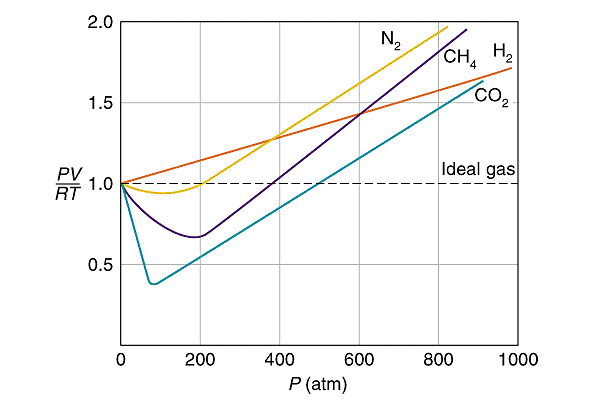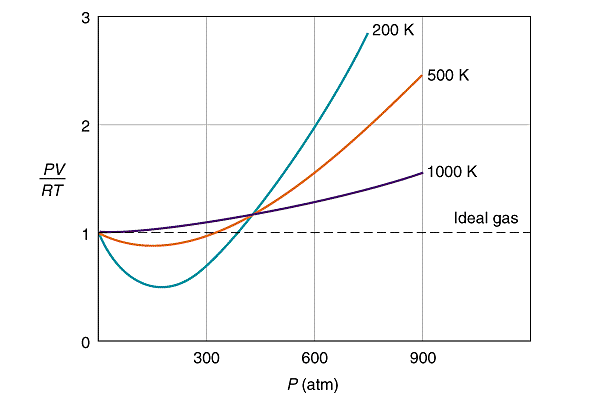Reacting masses and volumes

 1.3 Reacting masses and volumes (6 hours)
1.3 Reacting masses and volumes (6 hours)
Pause for thought
When solving many problems in physics at IB Diploma level it is usual to ignore friction. In a similar way when solving problems with gases chemists often tend to treat all gases as if they behave like ideal gases and ignore the fact that they do not. How valid is this assumption?


Pressure versus PV/RT for (a) real gases (on the left) at a fixed temperature and (b) nitrogen (on the right) at different temperatures
The closer the gas is to being a liquid then the less it behaves like a real gas as the particles themselves are moving slower, are more closely spaced and take up more of the ‘empty’ volume of the gas. Hence at high pressures and low temperatures there is considerable deviation from ideality. This can be seen from the two graphs. This deviation from ideal gas behaviour is on the current IB syllabus (see below). I think from a TOK standpoint students should be aware that they are making this assumption when dealing with real gases and be able to deduce from simple kinetic theory that a real gas will behave most like an ideal gas at low pressures and high temperatures.
As an aside can anyone explain why the graphs do not go through the origin? I understand that PV = nRT so when n = 1 mol PV/RT should be equal to 1 but when P = zero then PV/RT should be zero too? But I suppose when P = zero then V = infinity and zero multiplied by infinity can be anything you like. I guess I just do not understand maths!
Nature of Science
Evidence for scientific theories depends upon making careful observations. Avogadro’s initial hypothesis is a good example of this. The discovery of the first noble gas, argon, is another good example. In 1894 Lord Rayleigh gave a lecture to the Royal Society in which he stated that the density of nitrogen prepared from chemical reactions was 1.2505 g dm-3 whereas the density of nitrogen obtained from air by removing oxygen, carbon dioxide and water vapour had the value of 1.2572 g dm-3.
Based on this very slight difference in the measured densities, William Ramsey hypothesised that air must contain another unreactive gas that is heavier than nitrogen. Rayleigh and Ramsey then went on to isolate and identify argon.
Learning outcomesAfter studying this topic students should be able to: Understand:
Apply their knowledge to:
| Clarification notesA value of 2.27 × 10−2 m3 mol−1 (22.7 dm3 mol−1) is given in Section 2 of the data booklet for the molar volume of an ideal gas at STP. The ideal gas equation, pV = nRT is given in Section 1 of the data booklet and the value of 8.31 J K−1 mol−1 is given for the gas constant, R in Section 2. The units used for concentration can include: g dm–3, mol dm–3 and parts per million (ppm). Students should know that molar concentrations are denoted by the use of square brackets. International-mindednessThe SI unit of pressure is the Pascal (Pa), N m-2, but many other units remain in common usage both by scientists and non-scientists in different countries. Among them are atmosphere (atm), millimetres of mercury (mm Hg), Torr, bar and pounds per square inch (psi). The bar (1.00 x 105 Pa) is now widely used as a convenient unit, as it is very close to 1 atm and many weather maps show the pressure in millibars. The SI unit for volume is m3, although litre (dm3) is very commonly used. |
Teaching tipsThis is a big topic and one that you will probably keep coming back to and reinforcing throughout the course. This is particularly true with much of the practical work where students will need their knowledge of mole calculations to process their results. Impress upon them that the stoichiometry of the reaction is paramount when determining the limiting reagent. There may be more moles present of one particular reagent but it can still be the limiting reagent if more moles of it are required according to the equation. There are many good practicals you can give to illustrate the chemistry in this topic. I particularly like to get students to determine the molar mass of a gas. This can be the gas from your gas supply or from a canister such as a cigarette lighter. If you have an oven which can take a gas syringe then it is also good to determine practically the molar mass of a volatile liquid. Any one of these would fit the mandatory laboratory component listed in the ‘Applications and skills’ section. Students are also required to carry out a titration involving a standard solution. Although technically this does not have to be hands-on it would be a poor course where a student does not actually get to do a titration. A good simulation to show Boyle's and Charles' Laws is available free from You need to ensure that students are able to convert between units easily (e.g. from cm3 to m3 and from oC to K) in order to use the ideal gas equation correctly. As with all calculations it is better to train students to work it out from first principles rather than rely just on formulas. For example, they should understand that increasing the pressure on a gas will reduce the volume (if the other factors are kept constant) rather than just feed numbers into V1P1/T1 = V2P2/T2. For more on how students sometimes use formulas wrongly see the page on Misuse of formulas. | Study guide
Pages 4 - 7 QuestionsFor ten 'quiz' multiple choice questions with the answers explained see MC test: Reacting masses & volumes. For short-answer questions which can be set as an assignment for a test, homework or given for self study together with model answers see Reacting masses and volumes questions.Vocabulary listTheoretical yield IM, TOK, utilization etc.See separate page which covers all of Topic 1 Practical work
|
Teaching slides
Teachers may wish to share these slides with students for learning or for reviewing key concepts.
Other resources
1. If any of your students are having problems with basic titration calculations this simple video takes them through the process stepwise and then provides several examples fo rthem to do on thir own.
2. A video from Mark Rosengarten which outlines ideal gas behaviour and puts it all to music. Your students might enjoy it.
3. A handy calculator for all gas law calculations.
4. For an explanation of ppm and a practical 'utilization' see my blog on Malt whiskey and ppm.

 IB Docs (2) Team
IB Docs (2) Team 



























